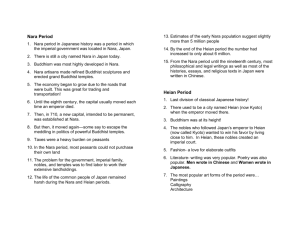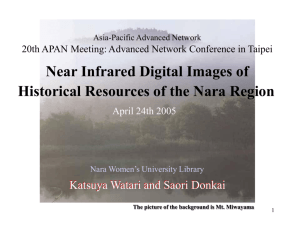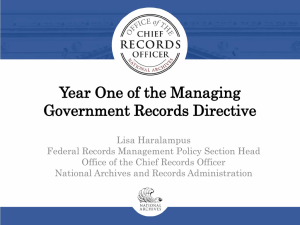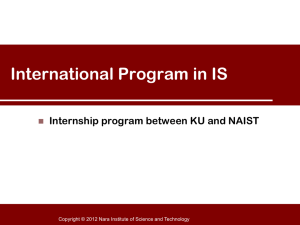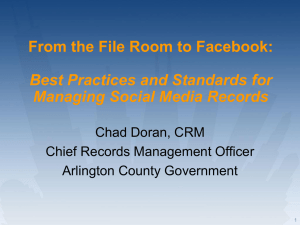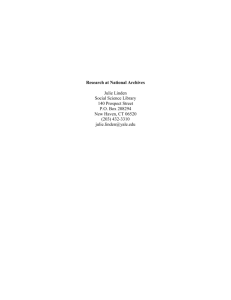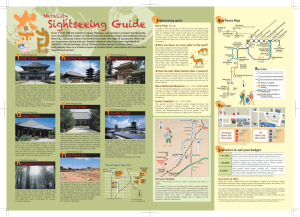bio - Diffusion of Social Media in Social Networks
advertisement
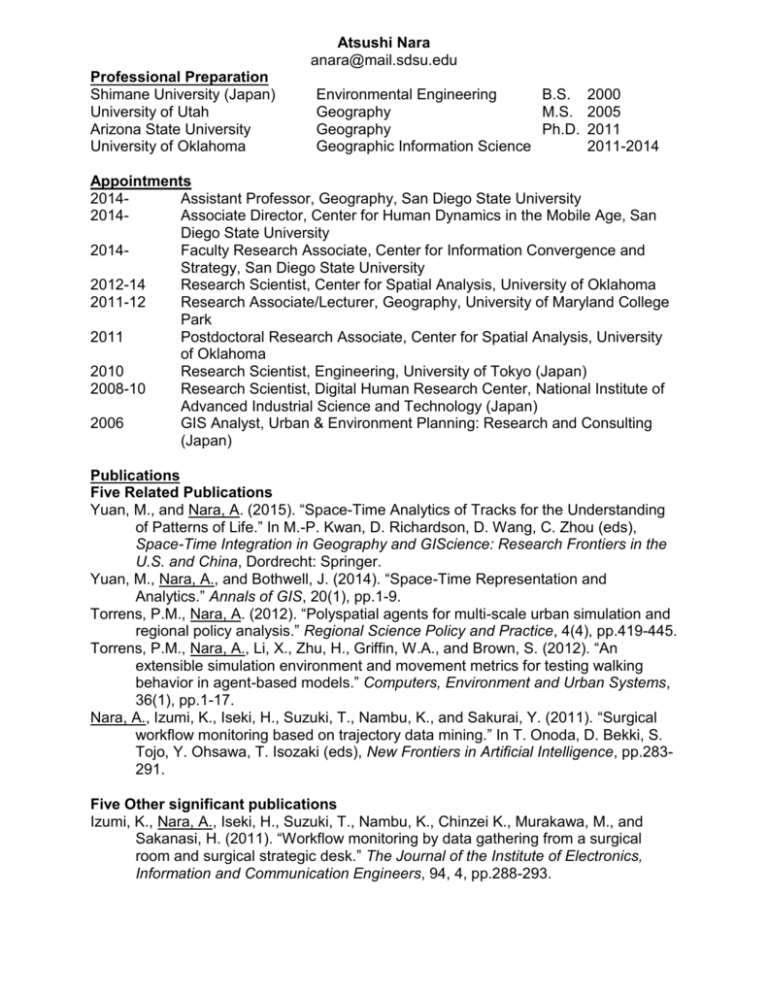
Atsushi Nara anara@mail.sdsu.edu Professional Preparation Shimane University (Japan) University of Utah Arizona State University University of Oklahoma Environmental Engineering B.S. Geography M.S. Geography Ph.D. Geographic Information Science 2000 2005 2011 2011-2014 Appointments 2014Assistant Professor, Geography, San Diego State University 2014Associate Director, Center for Human Dynamics in the Mobile Age, San Diego State University 2014Faculty Research Associate, Center for Information Convergence and Strategy, San Diego State University 2012-14 Research Scientist, Center for Spatial Analysis, University of Oklahoma 2011-12 Research Associate/Lecturer, Geography, University of Maryland College Park 2011 Postdoctoral Research Associate, Center for Spatial Analysis, University of Oklahoma 2010 Research Scientist, Engineering, University of Tokyo (Japan) 2008-10 Research Scientist, Digital Human Research Center, National Institute of Advanced Industrial Science and Technology (Japan) 2006 GIS Analyst, Urban & Environment Planning: Research and Consulting (Japan) Publications Five Related Publications Yuan, M., and Nara, A. (2015). “Space-Time Analytics of Tracks for the Understanding of Patterns of Life.” In M.-P. Kwan, D. Richardson, D. Wang, C. Zhou (eds), Space-Time Integration in Geography and GIScience: Research Frontiers in the U.S. and China, Dordrecht: Springer. Yuan, M., Nara, A., and Bothwell, J. (2014). “Space-Time Representation and Analytics.” Annals of GIS, 20(1), pp.1-9. Torrens, P.M., Nara, A. (2012). “Polyspatial agents for multi-scale urban simulation and regional policy analysis.” Regional Science Policy and Practice, 4(4), pp.419-445. Torrens, P.M., Nara, A., Li, X., Zhu, H., Griffin, W.A., and Brown, S. (2012). “An extensible simulation environment and movement metrics for testing walking behavior in agent-based models.” Computers, Environment and Urban Systems, 36(1), pp.1-17. Nara, A., Izumi, K., Iseki, H., Suzuki, T., Nambu, K., and Sakurai, Y. (2011). “Surgical workflow monitoring based on trajectory data mining.” In T. Onoda, D. Bekki, S. Tojo, Y. Ohsawa, T. Isozaki (eds), New Frontiers in Artificial Intelligence, pp.283291. Five Other significant publications Izumi, K., Nara, A., Iseki, H., Suzuki, T., Nambu, K., Chinzei K., Murakawa, M., and Sakanasi, H. (2011). “Workflow monitoring by data gathering from a surgical room and surgical strategic desk.” The Journal of the Institute of Electronics, Information and Communication Engineers, 94, 4, pp.288-293. Nara, A., and Torrens, P.M. (2011). “Trajectory Data Mining: Classification and SpatioTemporal Visualization of Mobile Objects.” Proceedings of the GeoComputation 2011, University College London, UK, July 20-22. Nara, A., Izumi, K., Iseki, H., Suzuki, T., Nambu, K., and Sakurai, Y. (2009). “Surgical workflow analysis based on staff's trajectory patterns.” Proceedings of the 1st Workshop on Modeling and Monitoring of Computer Assisted Interventions (M2CAI). Torrens, P.M. and Nara, A. (2007). “Modeling gentrification dynamics: A hybrid approach.” Computers, Environment and Urban Systems, 31, pp.337-361. Nara, A. and Torrens, P.M. (2007). “Spatial and temporal analysis of pedestrian egress behavior and efficiency.” Proceedings of Association of Computer Machinery (ACM) Advances in Geographic Information Systems, pp.284-287. Synergistic Activities 1. Development of an agent-based simulation model of pedestrian crowds under emergency evacuation situations and a suite of trajectory data mining and visualization methods for investigating pedestrian egress behaviors on streets. 2. Development of algorithms, toolkits, an integrated database management system, and a web portal that help GPS offender monitoring programs by fusing multiple data sources, analyzing and visualizing the datasets, and finding patterns of routine activities, abnormal tracks, potential offenses, and potential social networks. 3. Development of an online monitoring system and trajectory data mining methods to track and analyze movement characteristics of multiple surgical staff during a surgical operation for automatic recognition of surgical workflows. 4. Development of curricular materials for undergraduate and graduate level courses in GIScience. 5. Active and frequent external referee for papers on the connections between Geographic Information Science, human dynamics and disaster events to journals such as International Journal of Geographic Information Science, Georisk, Spatial Cognition and Computation, and Computers, Environment and Urban Systems.
